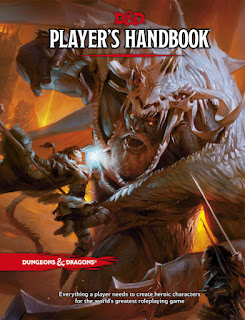Yesterday’s post slapped the women’s image magazine Uncanny around pretty hard for being a vapid and shallow periodical that dilutes the deep and rich medium of storytelling by using it as a medium for do-nothing wish fulfillment. It’s a great article, and every fan of short form fiction magazine, and long form fiction in general, should read it, link to it, and share it with friends, family, and random homeless people on the street.
 |
| Verbs are your friends. |
Near the conclusion of the post, a small compliment on the art itself included a teaser for today’s post. To whit, images that feature strong characters doing nothing other than charactering around can serve as effective cover art, but not for a book or collection of stories where things happen and people take action. Fortunately, there is a whole genre of books that do almost nothing but describe characters.
They’re called Player Character Manuals. They are written for – nerd alert! – Role Playing Games, or RPGs. They provide rules and suggestions and inspiration for players who are creating characters. These are not collections of stories, merely collections of characters or character traits that one could use to build a character. The characters built by these books do things on the table or in the game or in your head. However you want to look at it.
These covers aren’t meant to sell potential buyers on the exploits contained within, but on the exploits potential buyers can proxy-conduct using characters they build using the contents of the book. In this case, the producers aren’t so much selling the stories as they are selling the characters. As such, this is the perfect place for a cover featuring a character just standing there being characterful. The producers don’t need a story or conflict on the cover because there aren’t any stories or conflict in the book.
(If you’re lucky. Fall too many games include execrable excerpts of the writing that was so good…it’s author does technical writing for games.)
These covers tell the buyer, you can make this. You can make this do what you want. They sell the actual contents of the book. When used this way the art isn’t selling the image of a character, but the depths of what makes the character work. Literally. How the character works within the overall framework of the rules of the game.
To see some examples of static characters on a cover in action, let’s look at a few of the covers for the grand-daddy of them all, Dungeons and Dragons. Working without the benefit of state-paid Benefits or a debilitating mental disease along the lines of autism or OCD, we’re not going sit and pore through countless covers compiling, indexing, and choosing which data points fit the pre-selected narratives. We’ll leave that to overweight, rainbow haired, grudge farmers.
Bang, right out of the gate, the very first incarnation of the game, the manual for men and men-at-arms features a character just standing there in all his fantasy-armor glory. Score one for the Counter-Narrative. Moving on to the first cover for AD&D…
The aftermath of a fight. This one breaks the mold, conveying a sense of mystery and exploration rather than characters, but it’s thirty years old and produced by people just finding their way through an unknown hobby, we can cut it some slack. It’s not static characters, though, it’s characters doing – or just having done – things. So how about the second edition?
Here we see a mounted warrior charging an enemy, the reader presumably. It shows the action and conflict one might expect to be able to conduct with characters built using the system. Almost as if they decided to skip the ‘being’ and get right to the ‘doing’. My theory isn’t looking too great right now.
The third edition was a faux-jeweled leather affair meant to represent an actual manual, so we’ll skip it. Fourth edition, though…
Nailed it! Two characters just standing there waiting for something to happen, the way the gods and The Narrative intended. They don’t have to do anything, they just need to stand there pensively, like characters in a Spielberg monster movie. And of course, the most recent edition…
Huh. Again we see a character engaged in conflict, the root of all stories and adventure. Almost as if story and adventure are central to a game about stories and adventure. Oh, my precious theory!
That was an interesting experiment. The only manual feature characters standing around being characters was also the manual from the least successful edition of the biggest adventure game on the market. That should tell us something.
Since we’re not scientists, we’re not going to pout and start looking for data that supports our original hypothesis until we find enough to be proven right, damn it. Instead, we’re going to take the data and revise our theory about do-nothing characters on covers.
You can use them to sell books about story-telling and action centered games and magazines, but if you do you’re going to move less product than if you had used action packed art featuring stories and adventure.
And that’s how you do critical theory and analysis, bitches!






